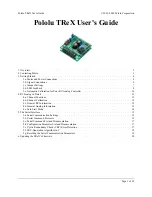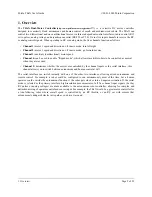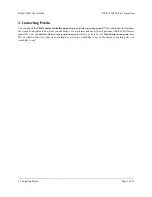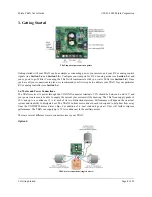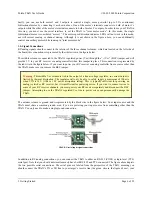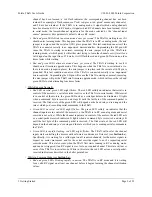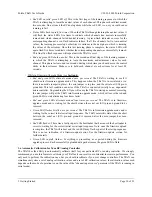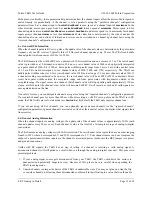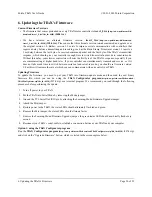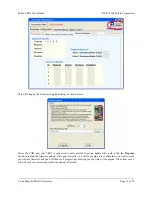
Perhaps most noticeably, these parameters help determine how the channel inputs affect the motors. Motor speed is
scaled linearly (or parabolically, if the channel is set as parabolic using the “parabolic channels” configuration
parameter) from 0 at a channel input of
deadband
to max speed at a channel input of
maximum
. In the
other direction, motor speed goes from 0 at
neutral-deadband
to max speed at
minimum
. Motor speed is 0 for
channel inputs between
neutral-deadband
and
deadband
, and motor speed is at a maximum for channel
inputs greater than
maximum
or less than
minimum
. Motor direction is determined by the side of neutral the
channel input is on, and notions of forward and reverse can be switched on a channel by channel basis using the
“reversed channels” configuration parameter.
4.c. General RC Information
When the channel inputs are RC servo pulses, the update rate of the channel values is determined by the pulse-train
frequency of your RC receiver. Typically this is 50 Hz (each channel updates every 20 ms). The TReX can handle
channel pulse-train frequencies of 10 Hz to 125 Hz.
The TReX measures the width of RC servo pulses with 12-bit resolution and an accuracy of 1 us. The raw channel
value is provided as a 12-bit number in units of 0.4 us, so a raw channel value of 2500 can be physically interpreted
as a pulse width of 2500×0.4 =1500 us. Servo pulse widths typically range from 1 ms to 2 ms, with a neutral value
of 1.5 ms. This would correspond to raw channel values of 2500, 5000, and 3750, respectively. The TReX can
handle pulse widths as short as 0.5 ms (raw channel value 1250) and as long as 2.5 ms (raw channel value 6250). If
a channel reading is considered to be an error, the raw channel value will be 0xFFFF (65535 in decimal). Errors
result from pulse widths outside the acceptable range and from pulse trains with frequencies outside of the
acceptable range. If a signal ceases on a channel, that channels value will stop updating until approximately 150 ms
elapse, at which point the channel’s raw value will become 0xFFFF. It will remain as such until valid signals are
once again detected on the line.
As a safety feature, you can designate channels as
required
using the “required channels” configuration parameter.
If a required channel goes for more than 500 ms without receiving a valid RC servo pulse and the TReX is in RC
mode, the TReX will enter safe-start mode (see
Section 4.e
). By default, the TReX only requires channel one.
If you are not using all five channels, you can optionally ignore unused channels via the “ignored channels”
configuration parameter. Ignored channels are treated as fixed at their neutral values (no matter what signals their
lines receive).
4.d. General Analog Information
When the channel inputs are analog voltages, the update rate of the channel values is approximately 50 Hz (each
channel updates every 20 ms or so). Each channel’s value is the result of a 16-sample average of analog-to-digital
conversions.
The TReX measures analog voltages with 10-bit resolution. The raw channel value is provided as a number ranging
from 0 to 1023, where 0 corresponds 0 V and 1023 corresponds to 5 V. Your channel source can be as simple as the
output of a potentiometer whose inputs are the channel’s associated power (make sure the BEC jumper is in place)
and ground connections.
Unlike with RC signals, the TReX has no way of telling if a channel is receiving a valid analog signal. A
disconnected channel will still produce a result when run through the analog-to-digital converter. This poses two
potential problems:
1. If your analog signal source gets disconnected from your TReX, the TReX could drive the motors in
unexpected and potentially dangerous ways. Because of this, please be very careful when operating the
TReX in analog mode.
2. Unused channels can impact behavior of the TReX in undesirable ways. You may not plan on using the flip
or override channels, but leaving them disconnected could result in their floating to a value that would enable
Pololu TReX User's Guide
© 2001–2009 Pololu Corporation
4. RC/Analog in Detail
Page 13 of 22

